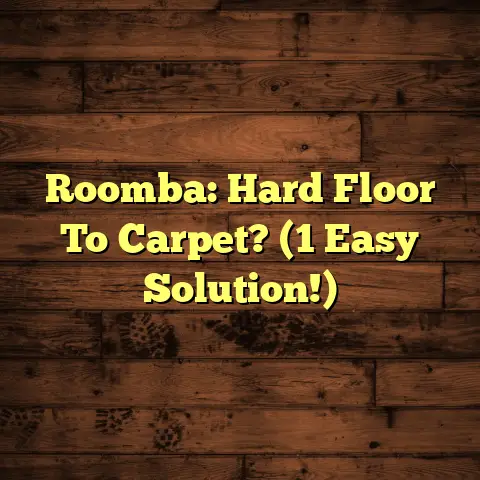Floor vs. Flooring? (1 Key Material Difference!)
Imagine stepping into a room where the floors gleam like sunlight dancing on water, a vibrant splash of color that breathes life into every corner.
The floor beneath your feet doesn’t just support your weight; it tells a story, sets a mood, and defines the character of your home.
As a flooring contractor for over 15 years, I’ve seen firsthand how the right flooring can completely transform a space.
But before we dive into the beautiful world of wood, tile, and carpet, let’s clear up a common confusion: What’s the difference between a “floor” and “flooring?”
Section 1: Defining Floor vs. Flooring
Think of it this way: the “floor” is the foundation, the structural base upon which everything else rests.
It’s the unsung hero, often hidden beneath layers
of beauty.
“Flooring,” on the other hand, is the
star of the show – the material you see, feel,
and walk on every day.
Floor: This refers to the structural element
that forms the bottom surface of a room.
It’s
the underlying base, providing support and
stability.
Think of it as the skeleton of your room’s
foundation.
Materials used for floors are typically
concrete or wood joists.
Flooring: This refers to the material or coverings
applied to the floor surface.
It’s the aesthetic
layer, chosen for its appearance, texture, and
functionality.
Examples of flooring include hardwood, laminate, tile, carpet, vinyl, and more.
To put it simply, the floor is what is, and the flooring is what you put on it.
For example, in many homes, you might have a
concrete floor in the basement.
But you wouldn’t
leave it bare, right?
You’d likely cover it with some type of flooring, like epoxy, tile, or even carpet squares to make it more comfortable and visually appealing.
Another common example is a subfloor made of
plywood.
This is the “floor,” and on top of that,
you might install hardwood flooring.
The plywood provides the necessary support, while the hardwood provides the desired look and feel.
Section 2: The One Key Material Difference
Now, let’s get to the heart of the matter: the one key material difference between “floor” and “flooring.”
It all boils down to structural integrity vs. aesthetic appeal.
The floor is all about strength and stability.
It needs to be able to bear the weight of the
room’s contents, including furniture, appliances,
and people.
That’s why floors are typically made of materials like concrete or wood joists, engineered to withstand heavy loads and resist bending or cracking.
Flooring, on the other hand, is primarily about aesthetics and comfort.
While durability is still important, the primary focus is on how the flooring looks, feels, and complements the overall design of the space.
This is why flooring materials are much more diverse
than floor materials.
You have everything from
natural materials like hardwood and stone to
synthetic materials like vinyl and laminate.
Each material offers a unique combination of appearance, texture, and performance characteristics.
Here’s a quick breakdown:
The implications of this difference are significant.
For example, if you have a damaged floor (like a cracked concrete slab), you’ll need to address the structural issue before you can even think about installing new flooring.
Ignoring the underlying floor problems can lead to serious issues down the road, such as uneven floors, squeaking, and even structural instability.
On the other hand, if your flooring is simply worn or outdated, you can replace it without necessarily having to worry about the underlying floor structure.
Of course, it’s always a good idea to inspect the floor before installing new flooring to ensure that it’s in good condition.
Section 3: The Role of Floors in Building Design
The floor plays a crucial role in building design, often overlooked but absolutely essential.
Architecturally, it’s the base upon which the
entire structure rests.
It provides a level surface
for construction and helps distribute the weight
of the building evenly.
Without a properly designed and constructed floor, the entire building could be at risk of collapse.
In residential design, the floor influences the
layout and flow of the space.
The placement of
walls, doors, and windows is often dictated by
the floor plan.
Different types of floors are used in various architectural styles.
For example, in modern homes, you might see polished concrete floors, which offer a sleek and minimalist look.
In traditional homes, you might see hardwood floors or tile floors, which add warmth and character.
In commercial buildings, floors are often designed to be durable and easy to maintain.
Concrete floors, epoxy floors, and vinyl floors are all popular choices for commercial spaces.
Industrial buildings often have reinforced concrete floors to withstand heavy machinery and equipment.
Here are some examples of different types of floors in various architectural styles:
- Residential:
- Modern: Polished concrete, engineered hardwood
- Traditional: Hardwood, tile, natural stone
- Coastal: Wide-plank wood, tile
- Commercial:
- Retail: Polished concrete, vinyl, tile
- Office: Carpet, laminate, vinyl
- Restaurant: Tile, epoxy, sealed concrete
- Industrial:
- Warehouse: Reinforced concrete
- Manufacturing: Epoxy, sealed concrete
The choice of floor material can also impact the
acoustics of a space.
Hard surfaces like concrete
and tile tend to reflect sound, while soft surfaces
like carpet tend to absorb sound.
This is why you often see carpet used in offices and libraries, where sound absorption is important.
Section 4: Aesthetic Appeal of Flooring
Now, let’s talk about the fun part: the aesthetic appeal of flooring!
Flooring is one of the most visible elements of
interior design.
It can dramatically affect the
look and feel of a room.
With so many different materials, colors, patterns, and textures to choose from, the possibilities are endless.
Here’s a quick rundown of some popular flooring options:
- Hardwood: Classic and timeless, hardwood
adds warmth and elegance to any space.
It’s durable, long-lasting, and can be refinished multiple times. - Tile: Versatile and durable, tile is a great
choice for kitchens, bathrooms, and entryways.
It’s water-resistant, easy to clean, and comes in a wide variety of colors and styles. - Carpet: Soft and comfortable, carpet adds
warmth and texture to any room.
It’s a great choice for bedrooms, living rooms, and playrooms. - Laminate: Affordable and easy to install,
laminate is a popular alternative to hardwood.
It’s durable, scratch-resistant, and comes in a variety of styles. - Vinyl: Water-resistant and durable, vinyl
is a great choice for bathrooms, kitchens, and
laundry rooms.
It’s affordable, easy to clean, and comes in a variety of styles.
Flooring choices can greatly enhance the aesthetic appeal of a room and contribute to interior design themes.
For example, hardwood floors can create a warm and inviting atmosphere, while tile floors can create a sleek and modern look.
Carpet can add a touch of luxury and comfort, while laminate can provide a cost-effective alternative to hardwood.
Here are some current trends in flooring design:
- Eco-friendly options: Sustainable flooring materials like bamboo, cork, and reclaimed wood are becoming increasingly popular.
- Color trends: Gray tones, natural wood tones, and bold colors are all trending in flooring design.
- Texture variations: Textured flooring, such as hand-scraped hardwood and embossed laminate, adds visual interest and depth to a room.
According to Statista, the global flooring market is projected to reach $428.5 billion by 2027, driven by increasing demand for residential and commercial construction.
This growth is fueled by the increasing popularity of new and innovative flooring materials, as well as the growing trend towards sustainable building practices.
Section 5: Installation and Maintenance
The installation process varies significantly depending on the type of flooring you choose.
Hardwood floors typically require professional installation, while laminate and vinyl floors can often be installed by experienced DIYers.
Tile floors require specialized tools and skills, so professional installation is usually recommended.
Carpet installation can be tricky, so it’s often best left to the professionals as well.
Here’s a quick comparison of the installation processes for different flooring types:
Maintenance requirements also vary depending on the type of flooring.
Hardwood floors require regular sweeping and occasional refinishing.
Tile floors are easy to clean and maintain, but the grout may require occasional sealing.
Carpet requires regular vacuuming and occasional shampooing.
Laminate and vinyl floors are easy to clean and require minimal maintenance.
Proper care is essential to prolonging the lifespan of both the floor and the flooring.
Ignoring maintenance can lead to premature wear and tear, which can be costly to repair.
Common issues homeowners face with flooring often reflect problems with the underlying floor.
For example, if you have uneven floors, it could be a sign of a structural problem with the floor.
If you have squeaking floors, it could be a sign of loose floor joists or subfloor.
If you have water damage to your flooring, it could be a sign of a leaky roof or plumbing problem.
Addressing these underlying floor problems is essential to ensuring the longevity and stability of your flooring.
Section 6: Environmental Considerations
The choice of flooring can have a significant impact on the environment.
Some flooring materials are more sustainable than
others.
For example, bamboo, cork, and reclaimed
wood are all considered eco-friendly options.
These materials are renewable, sustainable, and often made from recycled content.
Other flooring materials, such as vinyl and some types of carpet, can contain harmful chemicals that can off-gas into the air.
These chemicals can contribute to indoor air pollution and can have negative health effects.
Choosing low-VOC (volatile organic compound) flooring materials is a great way to reduce your environmental footprint and improve indoor air quality.
Here are some sustainable flooring options to consider:
- Bamboo: A fast-growing, renewable resource that’s durable and stylish.
- Cork: A sustainable material harvested from
the bark of cork trees.
It’s naturally resilient, water-resistant, and hypoallergenic. - Reclaimed wood: Wood salvaged from old
buildings, barns, and other structures.
It’s a great way to reduce waste and add character to your home. - Linoleum: A natural material made from
linseed oil, wood flour, and other renewable
resources.
It’s durable, water-resistant, and biodegradable.
The growing trend towards eco-friendly building practices is driving demand for sustainable flooring options.
Many homeowners and builders are now prioritizing environmental considerations when choosing flooring materials.
By choosing sustainable flooring, you can reduce your environmental footprint, improve indoor air quality, and create a healthier living environment.
According to the U.S.
Green Building Council,
choosing sustainable materials like flooring can
contribute to earning LEED (Leadership in Energy
and Environmental Design) certification for your
home or building.
LEED is a globally recognized green building rating system that promotes sustainable design and construction practices.
Section 7: Conclusion
So, there you have it: the difference between “floor” and “flooring.”
The floor is the structural base, while the flooring is the aesthetic covering.
Understanding this difference is essential for homeowners, builders, and designers alike.
It allows you to make informed decisions about flooring materials, installation, and maintenance.
It also helps you to address underlying floor problems that can affect the longevity and stability of your flooring.
As a flooring contractor, I’ve seen firsthand how the right flooring can transform a space.
It can add warmth, elegance, and character to any
room.
It can also improve indoor air quality and
reduce your environmental footprint.
The future of flooring is exciting.
With new
innovations in materials, design, and sustainability,
the possibilities are endless.
As we move forward, let’s continue to prioritize both the structural integrity of the floor and the aesthetic appeal of the flooring.
After all, the floor beneath our feet is more than
just a surface to walk on.
It’s the foundation
of our homes, our businesses, and our lives.
So, what kind of story do you want your floors to tell?





